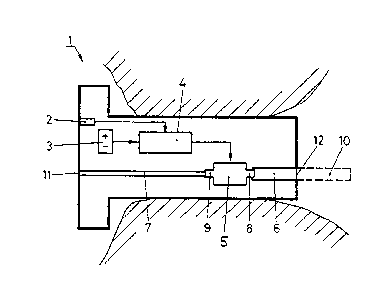Some of the information on this Web page has been provided by external sources. The Government of Canada is not responsible for the accuracy, reliability or currency of the information supplied by external sources. Users wishing to rely upon this information should consult directly with the source of the information. Content provided by external sources is not subject to official languages, privacy and accessibility requirements.
Any discrepancies in the text and image of the Claims and Abstract are due to differing posting times. Text of the Claims and Abstract are posted:
| (12) Patent Application: | (11) CA 2388321 |
|---|---|
| (54) English Title: | HEARING DEVICE |
| (54) French Title: | APPAREIL AUDITIF |
| Status: | Deemed Abandoned and Beyond the Period of Reinstatement - Pending Response to Notice of Disregarded Communication |
| (51) International Patent Classification (IPC): |
|
|---|---|
| (72) Inventors : |
|
| (73) Owners : |
|
| (71) Applicants : |
|
| (74) Agent: | ROBIC AGENCE PI S.E.C./ROBIC IP AGENCY LP |
| (74) Associate agent: | |
| (45) Issued: | |
| (86) PCT Filing Date: | 1999-11-08 |
| (87) Open to Public Inspection: | 1999-12-29 |
| Examination requested: | 2004-05-27 |
| Availability of licence: | N/A |
| Dedicated to the Public: | N/A |
| (25) Language of filing: | English |
| Patent Cooperation Treaty (PCT): | Yes |
|---|---|
| (86) PCT Filing Number: | PCT/CH1999/000524 |
| (87) International Publication Number: | WO 1999066779 |
| (85) National Entry: | 2002-05-06 |
| (30) Application Priority Data: | None |
|---|
The invention relates to a hearing device comprising a microphone (2), a
signal processing unit (4), an earphone (5) with two openings (8,9) and an
energy storage unit (3). The microphone (2) is connected to the signal
processing unit (4) which is in turn connected to the earphone (5). Means
(7,12,10) are also provided to allow the acoustic signals produced in the
earphone (5) to be propagated from one of the openings (8) into the auditory
canal of the person wearing the hearing device. The invention is characterized
in that other means (6,11) are also provided to enable the second opening (9)
of the earphone (5) to be linked to the outside world when the hearing device
is inserted into the ear of the wearer.
L'invention concerne un appareil auditif comportant un micro (2), une unité de traitement de signal (4), un écouteur (5), qui présente deux ouvertures (8, 9), et une unité d'accumulation d'énergie (3). Le micro (2) est relié à l'unité de traitement de signal (4) qui est elle-même reliée à l'écouteur (5). En outre, des moyens (7, 12, 10) servent à la propagation des signaux acoustiques produits dans l'écouteur (5) dans le canal auditif de la personne portant l'appareil, à partir d'une ouverture (8). L'invention se caractérise par le fait que d'autres moyens (6, 11) servent à relier la seconde ouverture (9) de l'écouteur (5) avec le monde extérieur, lorsque ledit appareil auditif est inséré dans l'oreille de l'utilisateur.
Note: Claims are shown in the official language in which they were submitted.
Note: Descriptions are shown in the official language in which they were submitted.

2024-08-01:As part of the Next Generation Patents (NGP) transition, the Canadian Patents Database (CPD) now contains a more detailed Event History, which replicates the Event Log of our new back-office solution.
Please note that "Inactive:" events refers to events no longer in use in our new back-office solution.
For a clearer understanding of the status of the application/patent presented on this page, the site Disclaimer , as well as the definitions for Patent , Event History , Maintenance Fee and Payment History should be consulted.
| Description | Date |
|---|---|
| Application Not Reinstated by Deadline | 2006-11-08 |
| Time Limit for Reversal Expired | 2006-11-08 |
| Inactive: IPC from MCD | 2006-03-12 |
| Deemed Abandoned - Failure to Respond to Maintenance Fee Notice | 2005-11-08 |
| Letter Sent | 2004-06-04 |
| All Requirements for Examination Determined Compliant | 2004-05-27 |
| Request for Examination Received | 2004-05-27 |
| Request for Examination Requirements Determined Compliant | 2004-05-27 |
| Inactive: Cover page published | 2002-10-18 |
| Letter Sent | 2002-10-10 |
| Inactive: Notice - National entry - No RFE | 2002-10-10 |
| Application Received - PCT | 2002-07-11 |
| National Entry Requirements Determined Compliant | 2002-05-06 |
| Application Published (Open to Public Inspection) | 1999-12-29 |
| Abandonment Date | Reason | Reinstatement Date |
|---|---|---|
| 2005-11-08 |
The last payment was received on 2004-09-09
Note : If the full payment has not been received on or before the date indicated, a further fee may be required which may be one of the following
Please refer to the CIPO Patent Fees web page to see all current fee amounts.
| Fee Type | Anniversary Year | Due Date | Paid Date |
|---|---|---|---|
| MF (application, 2nd anniv.) - standard | 02 | 2001-11-08 | 2002-05-06 |
| Registration of a document | 2002-05-06 | ||
| Basic national fee - standard | 2002-05-06 | ||
| MF (application, 3rd anniv.) - standard | 03 | 2002-11-08 | 2002-10-07 |
| MF (application, 4th anniv.) - standard | 04 | 2003-11-10 | 2003-09-26 |
| Request for examination - standard | 2004-05-27 | ||
| MF (application, 5th anniv.) - standard | 05 | 2004-11-08 | 2004-09-09 |
Note: Records showing the ownership history in alphabetical order.
| Current Owners on Record |
|---|
| PHONAK AG |
| Past Owners on Record |
|---|
| ANDRE VONLANTHEN |